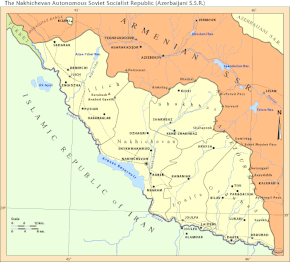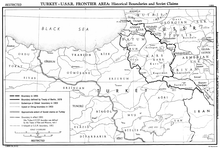Azerbaijan–Turkey border
The Azerbaijan–Turkey border (Azerbaijani: Azərbaycan–Türkiyə sərhədi,Turkish: Azerbaycan–Türkiye sınırı) is a short 17 km (11 mi) long international border between Azerbaijan and the Republic of Turkey.[2] The border is located at the southeastern tip of the Iğdır Province on the Turkish side and at the northwestern tip of the Nakhchivan Autonomous Republic on the Azerbaijani side; running entirely along the Aras river, it is the shortest border for both countries.
| Azerbaijan–Turkey border Azərbaycan–Türkiyə sərhədi Azerbaycan–Türkiye sınırı | |
|---|---|
 | |
| Characteristics | |
| Entities | |
| Length | 17 km (11 mi) |
| History | |
| Established | 16 March 1921[1] Signing of the Treaty of Moscow at the end of the Turkish-Armenian War |
| Current shape | 25 December 1991 Independence of Azerbaijan from the Soviet Union |
| Treaties | Treaty of Moscow, Treaty of Kars |
Geography
The Aras river marks the border for its entire length. The land in the immediate vicinity is flat and undeveloped, with the exception of a four-lane highway and two customs checkpoints. The nearest settlement is the village of Sədərək, located approximately 7 km (4.3 mi) east on the Azerbaijani side, while the nearest settlement on the Turkish side is the village of Aralık, located approximately 28 km (17 mi) northwest.
History


During the 19th the Caucasus region was contested between the declining Ottoman Empire, Persia and Russia, which was expanding southwards. Russia had conquered most of Persia's Caucasian lands by 1828 and then turned its attention to the Ottoman Empire.[3] With the 1829 Treaty of Adrianople (ending the Russo-Turkish War of 1828-29), by which Russia gained most of modern Georgia, the Ottomans recognised Russian suzerainty over Eastern Armenia.[3][4][5][6]
By the Treaty of San Stefano, ending the Russo-Turkish War (1877–1878), Russia gained considerable land in what is now eastern Turkey (termed Western Armenia), extending the Ottoman-Russian frontier south-westwards.[4][7][8] Russia's gains of Batumi, Kars and Ardahan were confirmed by the Treaty of Berlin (1878), though it was compelled to hand back part of the area around Bayazid (modern Doğubayazıt) and the Eleşkirt valley.[3][4][9]
During the First World War Russia invaded the eastern areas of the Ottoman Empire. In the chaos following the 1917 Russian Revolution the new Communist government hastily sought to end its involvement in the war and signed the Treaty of Brest-Litovsk in 1918 with Germany and the Ottoman Empire.[3] By this treaty, Russia handed back the areas gained by the earlier Treaties of San Stefano and Berlin.[4]
Seeking to gain independence from both empires, the peoples of the southern Caucasus had declared the Transcaucasian Democratic Federative Republic in 1918 and started peace talks with the Ottomans.[10][11] Internal disagreements led to Georgia leaving the federation in May 1918, followed shortly thereafter by Armenia and Azerbaijan. With the Ottomans having invaded the Caucasus and quickly gained ground, the three new republics were compelled to sign the Treaty of Batum on 4 June 1918, by which they recognised the pre-1878 border.[12][13]
With the Ottoman Empire defeated in Europe and Arabia, the Allied powers planned to partition it via the 1920 Treaty of Sèvres.[4][14] Turkish nationalists were outraged at the treaty, contributing to the outbreak the Turkish War of Independence; the Turkish success in this conflict rendered Sèvres obsolete.[4][3] Ottoman gains in Armenia were consolidated by the Treaty of Aleksandropol (1920).[4][3]
Armenia and Azerbaijan had fought for control of Nakhchivan, with Azerbaijan backing the pro-Azeri Republic of Aras. The dispute was rendered moot when, in 1920, Russia's Red Army invaded Azerbaijan and Armenia, ending the independence of both. In order to avoid an all-out Russo-Turkish war the two nations signed the Treaty of Moscow in March 1921, which created a modified Soviet-Ottoman border, granting Turkey a short strip of land connecting it to Nakhchivan.[4][15][16][3] Nakhchivan itself was confirmed as an autonomous region of Azerbaijan 1924.[17] However further fighting took place on the ground and the talks stalled; the treaty's provisions were later confirmed by the Treaty of Kars of October 1921, finalising what is now the Azerabaijan-Turkey border at its current position[4] The border was then demarcated on the ground in March 1925-July 1926 by a joint Soviet-Turkish commission.[4][3] Turkey's independence had been recognised by the 1923 Treaty of Lausanne.[18]
Azerbaijan was initially incorporated along with Armenia and Georgia in the Transcaucasian SFSR within the USSR, before being split off as the Azerbaijan Soviet Socialist Republic in 1936. The Kars Treaty border remained, despite occasional Soviet protests that it should be amended, notably in 1945.[3][19][20] Turkey, backed by the US, refused to discuss the matter, and the Soviets, seeking better relations with their southern neighbour, dropped the issue.[21][4]
Following the collapse of the USSR in 1991 Azerbaijan gained independence and inherited its section of the Turkey-USSR border.
Border crossings
There is only one crossing of the border.[22] The Umut Bridge carries the D.080/M7 highways across the Aras river. Plans for a railway into Nakhchivan from Turkey have been presented by the Turkish government since 2012, but no action was taken.
| Province | Province | Opened | Route in Turkey | Route in Azerbaijan | Status | ||
|---|---|---|---|---|---|---|---|
| Dilucu | Iğdır | Sədərək | Nakhchivan | 20 May 1992 | Open | ||
See also
- Azerbaijan-Turkey relations
References
- (in Russian) Московский договор между Росскией и Турцией, 16 марта 1921 года Archived 2007-09-28 at the Wayback Machine
- CIA World Factbook - Turkey, retrieved 6 April 2020
- The boundary between Turkey and the USSR (PDF), January 1952, retrieved 8 April 2020
- International Boundary Study No. 29 – Turkey-USSR Boundary (PDF), 24 February 1964, retrieved 8 April 2020
- John Emerich Edward Dalberg Acton (1907). The Cambridge Modern History. Macmillan & Co. p. 202.
- Tucker, Spencer C., ed. (2010). A Global Chronology of Conflict: From the Ancient World to the Modern Middle East. ABC-CLIO. p. 1154. ISBN 978-1851096725.
The Turks recognize Russian possession of Georgia and the khanates of Yerevan (Erivan) and Nakhichevan that had been ceded by Persia to Russia the year before.
CS1 maint: ref=harv (link) - Hertslet, Edward (1891), "Preliminary Treaty of Peace between Russia and Turkey. Signed at San Stefano 19 February/3 March 1878 (Translation)", The Map of Europe by Treaty; which have taken place since the general peace of 1814. With numerous maps and notes, IV (1875-1891) (First ed.), London: Her Majesty's Stationery Office, pp. 2672–2696, retrieved 2013-01-04
- Holland, Thomas Erskine (1885), "The Preliminary Treaty of Peace, signed at San Stefano, 17 March 1878", The European Concert in the Eastern Question and Other Public Acts, Oxford: Clarendon Press, pp. 335–348, retrieved 2013-03-04
- Holland, Thomas Erskine (1885), "The Preliminary Treaty of Peace, signed at San Stefano, 17 March 1878", The European Concert in the Eastern Question and Other Public Acts, Oxford: Clarendon Press, pp. 305–06, retrieved 2013-03-04
- Richard Hovannisian, The Armenian people from ancient to modern times, pp. 292–293, ISBN 978-0-333-61974-2, OCLC 312951712 (Armenian Perspective)
- Ezel Kural Shaw (1977), Reform, revolution and republic : the rise of modern Turkey (1808-1975), History of the Ottoman Empire and Modern Turkey, 2, Cambridge University Press, p. 326, OCLC 78646544 (Turkish Perspective)
- Charlotte Mathilde Louise Hille (2010), State Building and Conflict Resolution in the Caucasus, BRILL, p. 71, ISBN 978-9-004-17901-1
- Alexander Mikaberidze (2011), Conflict and Conquest in the Islamic World, ABC-CLIO, p. 201, ISBN 978-1-598-84337-8
- Helmreich, Paul C. (1974). From Paris to Sèvres: The Partition of the Ottoman Empire at the Peace Conference of 1919–1920. Columbus, Ohio: Ohio State University Press.
- Tsutsiev, Arthur (2014). Atlas of the Ethno-Political History of the Caucasus. Translated by Nora Seligman Favorov. New Haven: Yale University Press. p. 79. ISBN 978-0300153088.
- King, Charles (2008). The Ghost of Freedom: A History of the Caucasus. Oxford: Oxford University Press. p. 189. ISBN 978-0195177756.
- Shakarian, Pietro A. (23 February 2015). "Debunking a Caucasian Myth". The Abovyan Group. Retrieved 24 March 2017.
- Treaty of Peace with Turkey signed at Lausanne, Lausanne, Switzerland, 24 July 1923, retrieved 28 November 2012
- Khrushchev, Nikita S. (2006). Sergei Khrushchev (ed.). Memoirs of Nikita Khrushchev: Reformer, 1945-1964. Translated by George Shriver. University Park, PA: Penn State University Press. p. 426. ISBN 978-0271058597.
- Suny, Ronald Grigor (1993). Looking toward Ararat. Bloomington: Indiana University Press. pp. 165–169. ISBN 978-0253207739.
- Ro'i, Yaacov (1974). From Encroachment to Involvement: A Documentary Study of Soviet Policy in the Middle East, 1945-1973. Transaction Publisher. pp. 106–107.
- Caravanistan - Azerbaijan border crossings, retrieved 10 April 2020